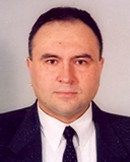
Plenary Lecture
“The Missing” Memristor - The Fourth Circuit Element. Analysis of Circuits with Memristors

Professor Valeri Mladenov
Dept of Theoretical Electrical Engineering
Technical University of Sofia
BULGARIA
E-mail: valerim@tu-sofia.bg
Abstract: In 2008, the HP laboratories researchers D. B. Strukov, G.S. Snider, D.R. Stewart, R.S. Williams published a paper in Nature (D. B. Strukov, G.S. Snider, D.R. Stewart, R.S. Williams, “The missing memristor found”, Nature, vol 453, pp. 80 – 83, May 2008), reporting the development of a new basic circuit element that completes the missing link between charge and flux linkage. This element was proposed by Chua in 1971 (L. O. Chua 1971, “Memristor – The Missing Circuit Element”, IEEE Trans. on Circuit Theory, vol. 18, pp. 507-519, Sept. 1971) as a missing non-linear passive two-terminal electrical element relating electric charge and magnetic flux linkage. The HP memristor is based on a nanometre scale titanium-dioxide thin film, containing a doped region and an undoped region. The memristors provide new paradigms in application-specific integrated circuits and field programmable gate arrays. A significant reduction in area with an unprecedented memory capacity and device density are the potential advantages of memristors for integrated circuits. The first part of the talk is dedicated to the history and development of the Williams’s memristor. The structure, the principle of action, basic parameters, the basic physical dependencies and basis of the physical processes of the titanium-dioxide memristor will be presented. The main formulae will be given as well.
The analysis that will be shown in the second part of the talk considers linear drift model of Williams’s memristor. A SIMULINK model of circuits with one, two and several memristors are build with obtained formulae and Kirchhoff’s voltage law. The basic results by the simulations organized in MATLAB and SIMULINK environment are given in graphical form. These results are associated with distortions of plateaus of impulses at different ratios r between resistances of “opened” and “closed” states of Williams’s memristor - ROFF and RON. There are given also interpreting of results, which confirms that a memristor with high ratio r is better than a memristor with small value of r. In conclusion there are given basic deductions and perspectives for future applications of memristor circuits.
Brief Biography of the Speaker: Valeri Mladenov graduated in Electrical Engineering (with distinction) from the Higher Institute for Mechanical and Electrical Engineering, Sofia (now Technical University of Sofia), Bulgaria in1985. He received his Ph.D. from the same institution in 1993. Since 1986 he has been a Lecturer in the Department of Theory of Electrical Engineering at the Technical University of Sofia Bulgaria, teaching courses on "Circuit Theory I & II", "Electrical Engineering", "Fuzzy Control and Neural Networks" and "Discrete Structures". In 2004 he becomes a Head of the Department of Theory of Electrical Engineering. In June 2011 he becomes a Dean of the Faculty of Automation and since December 2011 he is a Vice-Rector of the Technical University of Sofia. He is a guest lecturer at the Department of Electrical Engineering, Eindhoven University of Technology, the Netherlands, where he taught a course "Nonlinear Systems and Neural Networks". He has been invited lecturer in the Technical University of Ilmenau, Germany, National Technical University of Athens, Greece and many others.
Dr. Mladenov's research interests are in the field of nonlinear circuits and systems, neural networks, artificial intelligence, applied mathematics and signal processing. He has received many international research fellowships. He has more than 180 scientific papers in professional journals and conferences. He is a co-author of ten books and manuals for students. He have received many research grants from the Technical University of Sofia, Bulgarian Ministry of Education and Science, DAAD – Germany, NWO – Netherlands, Royal Society – UK, NATO,TEMPUS and others and also with his team he participated and now participate as a coordinator, team leader, etc. in many national and international projects (TEMPUS, DAAD, FP6, FP7).
As a member of several editorial boards Dr. Mladenov serves as a reviewer for a number of professional journals and conferences. He is a Senior Member of the Institute of Electrical and Electronics Engineering, Inc. (IEEE) http://www.ieee.org/, member of the IEEE Circuit and Systems Technical Committee on Cellular Neural Networks& Array Computing and Chair of the Bulgarian IEEE Circuit and Systems (CAS) chapter. He is also a member of the Steering Committee of the International Symposium on Theoretical Electrical Engineering (ISTET), member of the Board of Directors of the World Scientific and Engineering Academy and Society (WSEAS) http://www.wseas.org/ and editor-in-chief of the WSEAS Transactions on Circuits and Systems. He is an organizer and a chair of many International Conferences and Symposiums.